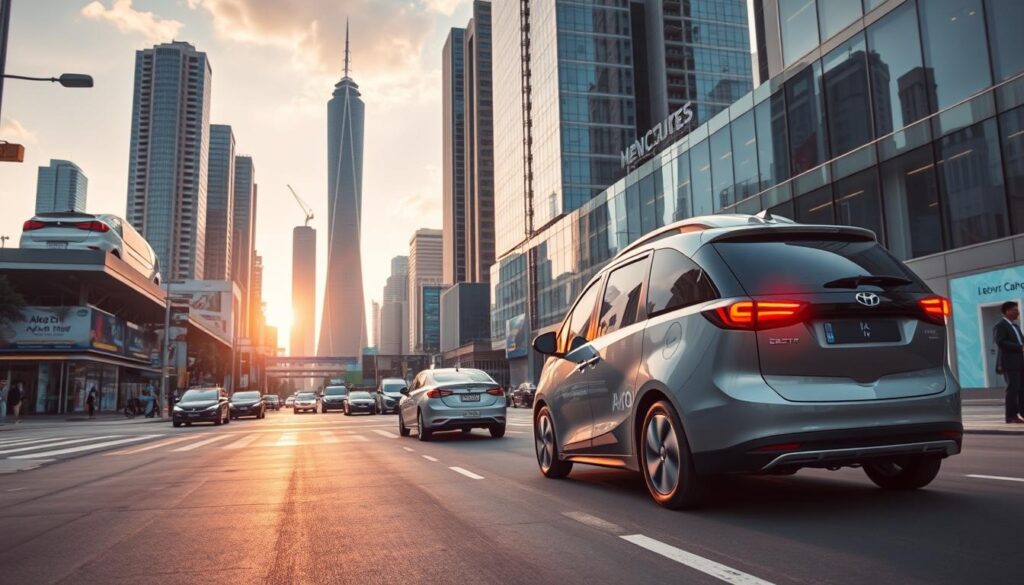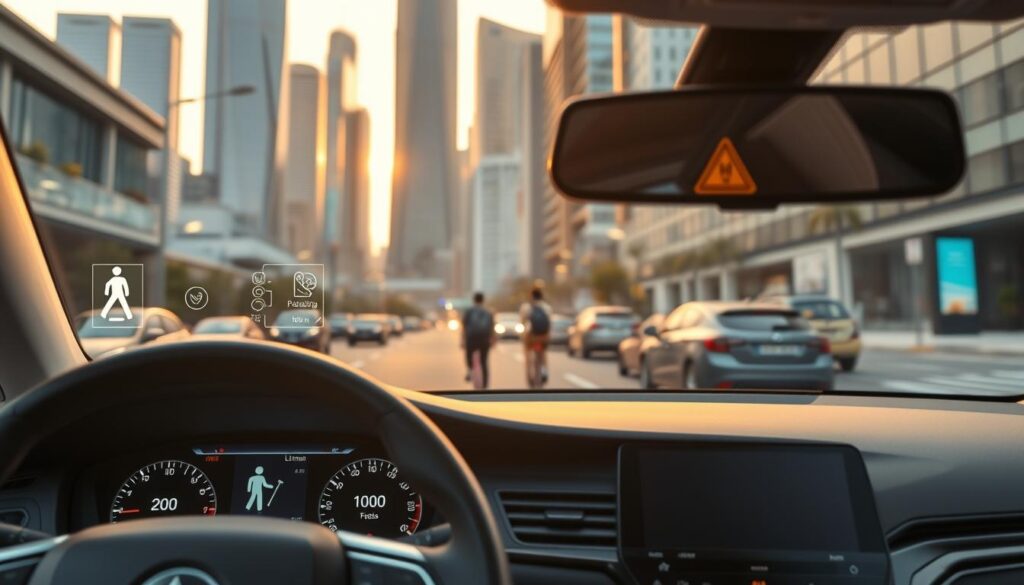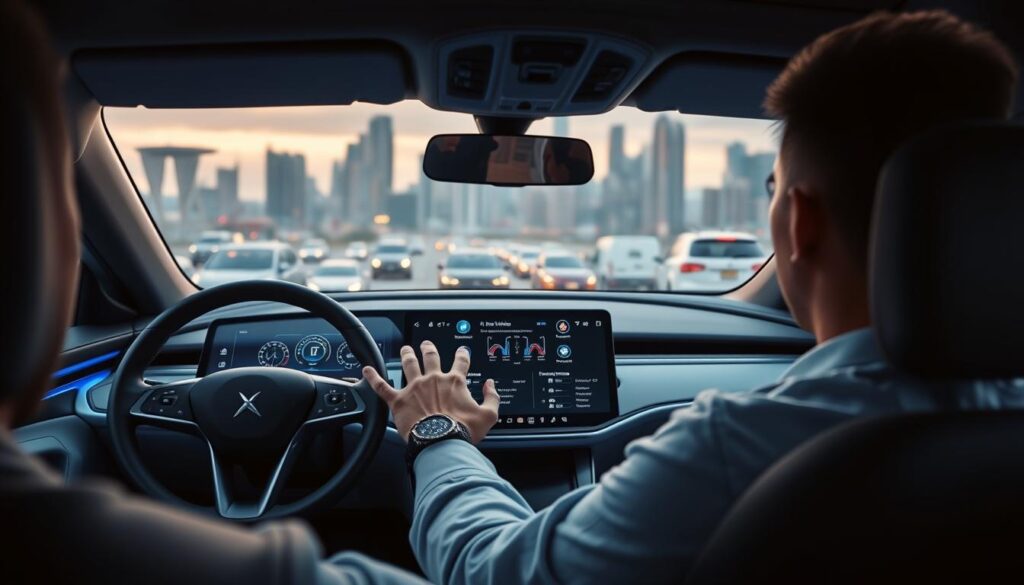Have you thought about how artificial intelligence is changing the car industry? It’s not just about self-driving cars. AI is making big changes in how cars are made, designed, and how we experience them. The market for automotive AI is expected to jump from ₱118.8 billion in 2019 to ₱899.1 billion by 2027. This shows how much people see AI’s value.
In today’s world, car companies are facing tough competition from tech startups. Using AI in cars is becoming key. A McKinsey survey found that 75% of car companies are using AI in design and making cars better. This helps make cars safer and more efficient by improving systems like ADAS and driving patterns. As the industry faces new challenges, using AI is seen as a crucial step forward.
Key Takeaways
- The automotive AI market is forecasted to grow by 362% from 2019 to 2025.
- AI enhances vehicle safety through Advanced Driver Assistance Systems, shifting focus from reactive to proactive measures.
- Major automotive companies are leveraging AI tools for innovations in design and manufacturing efficiency.
- Electric vehicles are at the forefront of adopting AI technologies for improved sustainability.
- Real-time vehicle communication via AI systems significantly enhances safety and responsiveness.
The Role of AI in the Future of Transportation
The car industry is on the verge of a big change, thanks to AI car technology. This tech changes how cars work and how they fit into their surroundings. We’re seeing trends that point to a future where cars can drive themselves better than ever before.
Current Trends in AI Car Technology
AI is making cars smarter with advanced driver-assistance systems (ADAS). These systems help cars stay in their lane and follow traffic smoothly. AI also helps predict when cars need repairs, saving the industry a lot of money by 2025.
AI cameras can alert drivers to dangers in real-time, cutting down on accidents by 20-30%. This makes driving safer for everyone.
AI isn’t just for cars; it’s also changing how cities manage traffic. For example, Singapore has seen a 25% drop in traffic jams thanks to AI. This shows how AI can make city travel much better.
Future Possibilities for Autonomous Vehicles
The future looks bright for self-driving cars, thanks to AI. Waymo has driven over 20 million miles without a human, showing AI’s potential. Companies like Tesla and GM are leading the way in making cars that can drive themselves.
As AI in cars grows, so does the market. It’s expected to reach ₱398.4 billion by 2027. Self-driving cars will use AI to make smarter choices and save fuel, possibly by 15%.
Overview of the Automotive Landscape in Southeast Asia
Southeast Asia’s car industry is changing fast, thanks to new tech and shifting tastes. The world’s car AI trends are hitting home here, as local and global brands chase the AI car market. This has sparked a battle among top players to lead with their latest innovations.
Key Market Players in the Region
Big names like Toyota, Ford, and Honda are key in Southeast Asia’s car world. They’re adding AI to make cars better and safer. Startups and tech firms are also joining, bringing AI to the table. The market is expected to grow a lot, showing the industry’s bright future.
Rising Demand for Innovative Solutions
People in the region want cars that are smart and new. This makes AI a big deal for car makers. The ASEAN Digital Masterplan 2025 highlights the need for digital growth. With AI, cars can get to know us better, making our drives more personal.

AI-Powered Vehicle Safety Features
AI has changed how cars are made safer. It makes many safety features better, making driving safer for all. With more accidents on the roads, new tech is key to reducing risks.
Collision Avoidance Systems
Collision avoidance systems use AI to watch the road around you. They quickly check what’s happening and help avoid crashes. Studies show a 30% drop in crashes with these systems.
Features like forward collision warning and automatic braking are now common. By 2030, they could cut road accidents by 40%.
Advanced Driver Assistance Systems (ADAS)
ADAS systems keep an eye on driving conditions always. They help with lane-keeping and braking, lowering accident rates. AI helps by watching for signs of tiredness or distractions.
AI systems have cut accidents by 25%. The market for these techs is expected to hit ₱1.71 trillion by 2025. This shows how much the industry is investing in safety.

Electric Vehicles: The Intersection of AI and Sustainability
The car industry is changing fast, thanks to electric vehicles and AI. More people want cars that are good for the planet. AI helps electric cars work better in many ways, like managing batteries and charging.
This mix of new tech and caring for the planet is leading us to a greener future. It’s all about making transportation better for our planet.
AI in Battery Management Systems
Battery systems are key for electric cars to perform well. AI helps by looking at data to optimize charging cycles. This makes batteries last longer and work better.
AI also helps predict when cars might need repairs. This stops cars from breaking down unexpectedly. It’s good for the planet and for car owners.
Companies Leading the Charge in EV Technology
Companies like Tesla and Nissan are leading the way with AI in electric cars. They use smart tech to make things run smoother and make more money. For example, smart charging stations use AI to charge cars when it’s best.
This makes charging faster and more convenient. It also helps reduce pollution from cars. It’s a big step towards a cleaner future.

Enhancing User Experience Through AI
In the automotive world, AI is changing how we interact with cars. It makes driving more comfortable and convenient. AI helps create smart infotainment systems that connect drivers and passengers in new ways.
Smart Infotainment Systems
Today’s infotainment systems use AI to make driving smoother. They learn what you like and adjust music and routes for you. This means you get music and directions that fit your style, making driving more enjoyable.

Personalization in Automotive Design
Car makers use AI to make cars that fit your needs. They analyze data to design cars that look good and work well. This means cars are not just pretty but also smart and comfortable.
AI helps make cars that feel like they were made just for you. For more on how AI changes things, see how AI improves customer experience and personalization.
Case Studies: Asian Companies Leveraging AI
Asian companies are leading the way in using AI in cars. They use AI to make their car-making process better, cheaper, and more innovative. Hyundai and Toyota are great examples of this, using new technologies to improve their work.
Hyundai’s Innovations in AI Integration
Hyundai is changing how cars are made with AI. They use smart robots and technology to make their production lines more efficient. This not only makes cars faster but also checks their quality with AI.
This shows how AI is changing old ways of making cars.
Toyota’s AI-Driven Manufacturing Processes
Toyota is known for using AI in its car-making. They use AI to predict when cars need repairs, which saves time and keeps cars running. This shows Toyota’s smart use of AI in making cars, making them a leader in the field.
The Impact of AI on Supply Chain Management
AI is changing how the automotive industry manages supply chains. It helps businesses work more efficiently and save money. Big car makers see AI as key to better logistics and performance.
This change makes shipping and delivery smoother. It also helps manage warehouse space better. This leads to more accurate tracking and forecasting of demand.
Optimizing Logistics with AI
AI is vital for making logistics better. It looks at data from many places to find and fix problems in supply chains. This cuts down on costs a lot.
For example, AI can make warehouse layouts and routes better. This means faster and more accurate delivery. AI systems also spot mistakes and defects quickly, reducing waste.
Predictive Analytics and Inventory Management
AI’s predictive analytics improve inventory management. It adjusts forecasts based on what customers do. This helps companies stay ready for changes in the market.
AI also predicts when equipment might break down. This cuts down on downtime and boosts efficiency. AI solutions make paperwork automatic, too. This makes things clearer and helps follow ethical rules.
Challenges and Considerations in Implementing AI
Integrating AI in cars faces many hurdles. It’s key to tackle these challenges for growth. Companies must focus on keeping data safe and private to win back trust.
Data Privacy and Security Issues
Data privacy is a big worry in car AI. The industry uses a lot of data from cars and systems. Managing this data well is hard, from how drivers act to how cars perform.
Following rules is crucial. Companies must balance new tech with keeping data safe. Strong systems are needed to protect data and make AI work well.
The Need for Skilled Workforce in AI Technologies
AI in cars is changing fast, and we need people who know how to use it. Finding and keeping good workers is tough. Training current staff is a smart move.
This helps everyone work better and innovate more. It’s important to close the skills gap. This way, AI can help make cars better for everyone.
The Future of AI in the Automotive Sector
The automotive sector is changing fast, thanks to AI. We’ll see more AI in cars, smarter traffic systems, and greener factories. AI is making cars safer and more efficient, improving how we travel.
Long-Term Trends to Watch
Right now, 44% of car companies are looking into AI for big changes. The market for car safety tech is growing fast, reaching ₱4.11 trillion by 2030. With 2 billion connected cars by 2025, AI will be key for safety and better car performance.
Opportunities for Business Leaders in Southeast Asia
Business leaders in Southeast Asia have big chances with automotive AI. The global market is growing fast, and using AI can make you stand out. Companies can cut costs and improve how they work with AI.
By using smart systems and AI, businesses can make cars safer and meet customer needs better. The future looks bright for those who invest in AI in cars.

